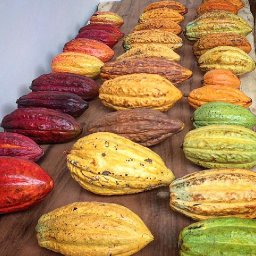Cocoa butter and cocoa solids
updated by @daniel-odoherty: 09/08/15 17:47:01
--
~~~~~~~~~~~~~~~~~~~~~~~~~~~~~~~~~~~~~~~~~~~~~~
@DiscoverChoc
--
~~~~~~~~~~~~~~~~~~~~~~~~~~~~~~~~~~~~~~~~~~~~~~
@DiscoverChoc
--
~~~~~~~~~~~~~~~~~~~~~~~~~~~~~~~~~~~~~~~~~~~~~~
@DiscoverChoc
--
~~~~~~~~~~~~~~~~~~~~~~~~~~~~~~~~~~~~~~~~~~~~~~
@DiscoverChoc
 The link I provided earlier mentioned that Callebaut's aerated chocolate chunks are cheaper than "normal" chunks, presumably because of less cocoa mass and more air, yet I wondered how that could be possible to account for the expenses in equipment, labor, packaging, marketing, etc. My guess is that the money a company saves by reducing cocoa mass is invested towards all those additional production and promotion costs so that it can at least break even, presuming of course the costs are nearly identical. If not, even then the company stands to gain by the increased market presence.
The link I provided earlier mentioned that Callebaut's aerated chocolate chunks are cheaper than "normal" chunks, presumably because of less cocoa mass and more air, yet I wondered how that could be possible to account for the expenses in equipment, labor, packaging, marketing, etc. My guess is that the money a company saves by reducing cocoa mass is invested towards all those additional production and promotion costs so that it can at least break even, presuming of course the costs are nearly identical. If not, even then the company stands to gain by the increased market presence.
updated by @edward: 09/12/15 10:01:40


Here are a few questions that came to my mind about this:
Does any other part of cocoa contribute fat?Is cocoa butter 100% fat? If its not, then there is even more cocoa butter than the fat content shows.
What are the typical weights (or percentages) of soy lecithin and vanilla? These must use some part of the cocoa total, but maybe its negligible.
Hans has a very thought provoking article in Cocoa Content called " Why cocoa content matters ".
In it he shows a very insightful way to determine the amount of cocoa butter. Here's the essence of it:Cocoa content only tells you how much of the bars weight is comprised of cocoa solids. Now, its important to understand that cocoa solids refers to the chocolates combined weight of cocoa butter and dry cocoa particles (i.e. cocoa powder). You can find the amount of cocoa butter from the amount of fat, though. Once you have that you can determine the percentage of the rest of the solids.Follow these steps from the nutrition label:
- Note the serving size, since it varies.
- Note the Total Fat The Fat is from cocoa butter
- Divide the Total Fat by the Serving size (Fat/Size), then multiply by 100 to get the percentage of fat
- Subtract the percentage of fat from the cacao percentage and the difference will tell you what percentage of the bar consists of dry cocoa solids.
Cocoa butter percentage + cocoa solids percentage = Total cacao percentage.For example, consider a bar of Lindt Excellence 70%. The Nutrition Facts show the serving size as 42g, with 17g of fat. Divide 17 by 42 and multiply the result by 100, and youll get 40. This means theres 40% cocoa butter. Subtract that number from 70, which in this case is 30% dry cocoa solids . (40 + 30 = 70)
What do you think of this?
updated by @chocofiles: 04/10/15 05:06:03
Tags
Activity
Two changes we made with the chocolate is that this time we winnowed the chocolate. This time we didn't use a blow dryer to melt the chocolate. Two improvements with the chocolate is that the melanger didn't get clogged this time and everyone put in work.
Our first podcast episode, Chocolate is Multiple, is live. Please listen and share your feedback!
TheChocolateLife celebrates its 9th anniversary this week, starting publication the week of January 18, 2008. Already planning a 10th Anniversary bash!
Food and Wine Magazine's list of top chocolates in the US.
This appears to have been put together by a committee (there is no byline) and by people who have little or no understanding of the chocolate business. Like most lists produced this way, it's very uneven - mixing very small producers with global mass-market brands, and not differentiation between chocolate makers and confectioners.
What are your thoughts?
This year 2016 was a good year for our small business in Belgium. We now are following some new (for us) small and unique chocolate makers. Such as: Ananda (Ecuador), The Wellington chocolate Factory, Acali, Potamac, Letterpress, PumpStreet Bakery, Dick Taylor and La Naya. We are proud to be the smallest chocolate shop in Belgium following some of the best chocolate makers in the world.
Wishing you all a Merry Christmas and a happy New Year 2016/2017



